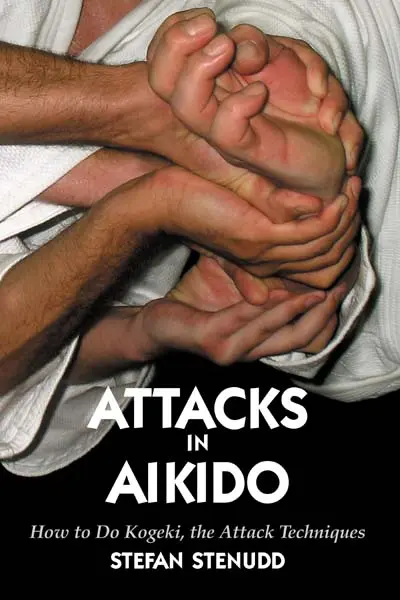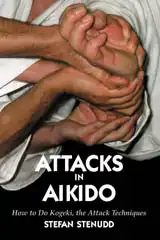The book:

Attacks in Aikido
How to do Kogeki, the Attack Techniques,
by Stefan Stenudd
For the first time: an aikido book that focuses on the attack techniques. Although aikido is a purely defensive martial art, attack techniques need to be practiced so that the training partners can exercise the defense against them.
It's easy to forget in regular aikido training. We all know that the aikido technique is the defense, not the attack, so that's what we focus on. But without skilled attacks, the aikido defense doesn't need to be skilled, so there's a risk it will not be, no matter how much we train. For your aikido skills to increase, your attacking skills must improve accordingly. That's what I had in mind when writing this book.
Click to see the book at Amazon >>>
Respect for Other Martial Arts
As far as I've seen, the aikido literature ignores the attacks completely, as if irrelevant to aikido training. Nothing could be more wrong. The attack and the defense are linked. The improvement of one demands the equal improvement of the other.
Also, we need to understand how skilled attacks are done, if we are to understand why the aikido techniques are the way they are. They are responses to the attacks — like a duet, not a solo performance.
I think that the key to good attack techniques in aikido is to study how they're done in the other martial arts, the ones with attacks on their curriculum.
For aikido it's particularly rewarding and relevant to study other budo, the traditional japanese martial arts. Strikes and kicks are karatedo specialities, grips are learned well in judo, sword attacks in kendo and iaido, and so on. This approach to the attacks deepens your understanding of the budo elements in aikido, which are quite fundamental.
By studying the attack techniques the way they've been refined in other budo, we learn why aikido looks the way it does.
The Book
This book presents all the attacks practiced in aikido — grips as well as strikes, punches, and kicks. Also attacks with sword, stick, and knife are included. Each of these attack techniques is examined in depth, with lots of advice and pointers for beginners as well as advanced aikido students.
The book also contains commented lists of all possible combinations of attack and defense techniques. A dictionary of the aikido terminology is included, too.
How to get the book
If you want to buy the book, you can do so at most Internet bookstores. Click the image below to see the book at Amazon (paid link). The link takes you to your local Amazon store (or to Amazon.com).


Click the header to visit the book's Facebook page.
Table of Contents
Here is the book's table of contents:
Foreword 9
Introduction 11
Tori and uke 12
Kogeki 15
Tables of techniques 17
Glossary 18
Attack basics 21
Empty mind 21
Pursue 23
Posture 24
Kamae 26
Functionality 28
Unbendable arm 30
Precision 32
Center 35
Ki 38
Ukemi 40
Kogeki – attacks in aikido 43
Aihanmi relation 45
Aihanmi katatedori 45
Shomenuchi 47
Shomenate 49
Tsuki 51
Maegeri 55
Gyakuhanmi relation 60
Gyakuhanmi katatedori 61
Ryotedori 62
Katadori 63
Ryokatadori 65
Munedori 66
Sodedori 67
Ryosodedori 68
Ryohijidori 69
Yokomenuchi 70
Katadori menuchi 72
Kata katatedori 74
Yokotsuki 75
Mawashigeri 76
Ushiro relation 80
Morotedori 80
Ushiro ryotedori 82
Ushiro ryokatadori 84
Kubishime 85
Eridori 88
Kakaedori 89
Ushiro ryosodedori 91
Ushiro ryohijidori 92
Strikes from behind 93
Weapons 95
Tanto (knife) 97
Bokken (sword) 105
Jo (staff) 127
Tables of the aikido techniques and attacks 145
General principles 146
Tori principles 148
Uke principles 150
Katamewaza (pinning techniques) 152
Nagewaza (throwing techniques) 154
Tachiwaza mae (standing, attacks from the front) 155
Tachiwaza ushiro (standing, attacks from the rear) 162
Suwariwaza (tori and uke sitting) 167
Hanmi handachiwaza (tori sitting, uke standing) 173
Tantodori (defense against knife) 179
Tachidori (defense against sword) 185
Jodori (defense against staff) 191
Kaeshiwaza (counter techniques) 196
Henkawaza (changed techniques) 200
Renzokuwaza (consecutive techniques) 205
Glossary of aikido terms 207
Foreword of the Book
Aikido is full of paradoxes. It is a peaceful martial art, which is in itself a seemingly impossible contradiction. But the principles and solutions of aikido actually make it true. Another paradox is that aikido really consists solely of defense techniques, but it is essential to learn attacks in order to master that defense.
Of course, the attacker is always the loser in aikido practice. We take turns attacking, so that our training partners can exercise the defenses. The goal of the training, though, is the defense. Learning how to attack is only sort of a side-effect.
Nonetheless, if you want to increase your skills in the aikido defense techniques, you must also improve your attack technique skills accordingly. They depend on one another. It is by experiencing advanced attacks that you are able to develop an advanced defense.
And when you have reached a fundamental understanding of attacks and the principles behind them, you will find the way to an aikido that transforms the attacker-defender polarity into a flow of forces, a dance of sorts, where the pair is so united that it seems like a solo. That’s when aikido becomes really enchanting.
There are many books about aikido, but as far as I know this is the first one about the attack techniques used in aikido practice. It is intended to work as a manual for beginners, as well as a useful tool for the advanced students.
As for my understanding of attacks in aikido, I am in debt to several prominent aikido teachers. Three come immediately to mind: Toshikazu Ichimura, who was my first Japanese teacher, always insisted on full-powered and focused attacks, Shoji Nishio was a master of precision in everything, with vast experience gathered from many budo arts, and Nobuyoshi Tamura creates a koan riddle each time he grabs my wrist.
I am also grateful to my dojo members Tomas Ohlsson and Jonas Dahlqvist, who assisted in the photo sessions, and to training partners as well as photographers at my seminars in Sweden, the Czech Republic, and Germany.
Samples
Here are two short chapters from the book, as Acrobat PDF files in computer screen resolution (72 DPI):
Introduction
Gyakuhanmi relation
About me
I started to practice aikido in 1972, when I was 18 years old. Now, I'm 7 dan Aikikai Shihan, member of the Swedish Aikikai Grading Committee, former Vice Chairman of the International Aikido Federation and President of the Swedish Budo & Martial Arts Federation. I teach aikido and iaido at the dojo Enighet in Malmö, Sweden, and at seminars in Sweden and other European countries.
Outside the dojo I'm a writer and historian of ideas. I've written a number of books in Swedish and English, both fiction and non-fiction. Among the latter are books about aikido and aikibatto, a guide to the life force qi, and a Life Energy Encyclopedia. I've also published a translation and commentary of the Chinese classic Tao Te Ching. In the history of ideas I study the thought patterns of creation myths, as well as Aristotle's Poetics.
My previous aikido books are Aikido Principles and Aikibatto: Sword Exercises for Aikido Students.
Attacks in Aikido
How to do Kogeki, the Attack Techniques
by Stefan Stenudd
Arriba Publ., 2008, 2020
Paperback, 228 pages
ISBN: 978-91-7894-088-2
My Aikido Books
Click the images to see the books at Amazon (paid link).
Basic Concepts of the Peaceful Martial Art. The basic principles, philosophy and traditional budo concepts in aikido.
More about the book here.
How to do kogeki, the attack techniques. All the attack techniques in aikido explained, and how to do them correctly.
More about the book here.
Aikiken Sword Exercises for Aikido. The aikibatto exercises, practical and spiritual aspects of the sword arts, advice on equipment for training.
More about the book here.
|

Aikido Menu
AIKIDO PRACTICE
AIKIDO THEORY
My Other Websites
Myths in general and myths of creation in particular.
The wisdom of Taoism and the
Tao Te Ching, its ancient source.
An encyclopedia of life energy concepts around the world.
Qi (also spelled
chi or
ki) explained, with exercises to increase it.
The ancient Chinese system of divination and free online reading.
Tarot card meanings in divination and a free online spread.
The complete horoscope chart and how to read it.

Stefan Stenudd
About me
I'm a Swedish author of fiction and non-fiction books in both English and Swedish. I'm also an artist, a historian of ideas, and a 7 dan Aikikai Shihan aikido instructor. Click the header to read my full bio.




 Aikido Principles
Aikido Principles Aikibatto
Aikibatto